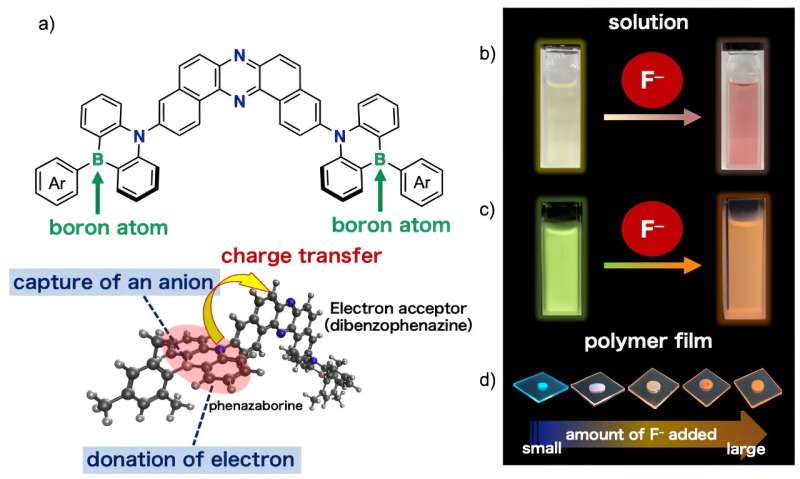This article has been reviewed according to Science X's editorial process and policies. Editors have highlighted the following attributes while ensuring the content's credibility:
fact-checked
peer-reviewed publication
trusted source
proofread
New colorful plastic films for versatile sensors and electronic displays

Innovative electronics is one of the many applications of modern plastics. Some recent research efforts have used plastic to improve the color realism of display technologies.
Now, in a study recently published in Angewandte Chemie International Edition, researchers from Osaka University and collaborating partners have developed a borane molecule that exhibits unusual light emission upon binding to fluoride. Incorporating their molecule into common plastic is straightforward, resulting in versatile materials for electronic display and chemical sensing applications.
A class of molecules known as triarylboranes (TABs) has photochemical properties that are useful in optics. For example, upon binding to an anion such as fluoride, disruption of the TAB electronic structure often does two things to the light emission: shortens the wavelength (blue-shift) and reduces the intensity (turn-off response).
Lengthening the emission wavelength (red-shift) is nearly unprecedented because corresponding design principles are unavailable. Developing a new class of TAB that exhibits a red-shifted sensing response and can be easily incorporated into plastic electronics and similar technologies is the problem the researchers aimed to address.
"Our borane-based sensor exhibits a red-shifted response upon binding to an anion such as fluoride," explains Nae Aota, lead author of the study. "Our method is based on reducing orbital energy gap of the molecule in the ground state and enhancing charge-transfer in the excited state by reversing the role of TAB from electronic acceptor to donor."
A highlight of the researchers' work is the facile incorporation of a TAB–fluoride into polystyrene and poly(methyl methacrylate) polymer films. The polymer matrix did not impair the red-shifted light emission. In fact, one film exhibited warm white light—a highly desired property that mimics sunlight. Furthermore, the color of the light emission was finely tunable by simply adjusting the quantity of added fluoride.
"We're excited by the versatility of our thin films," says Youhei Takeda, senior author. "We can use the bipolarity of the phenazaboride to prepare plastic films ranging from blue to near-infrared for displays and ultra-sensitive anion detection."
This work is an important step forward in electronic display technologies. Furthermore, by tuning the selectivity of the TAB to anion binding (i.e., detecting only one type of anion even in the presence of other potentially competing anions), applications to highly sought sensing technologies will be straightforward.
More information: Nae Aota et al, Anion‐Responsive Colorimetric and Fluorometric Red‐Shift in Triarylborane Derivatives: Dual Role of Phenazaborine as Lewis Acid and Electron Donor, Angewandte Chemie International Edition (2024). DOI: 10.1002/anie.202405158
Journal information: Angewandte Chemie International Edition
Provided by Osaka University




















